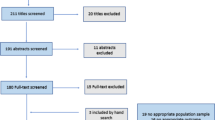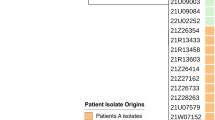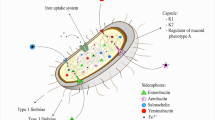Abstract
Thus far there is little data available concerning Acanthamoeba associated amoebic keratitis (AK) from Italy. In order to understand the incidence of Acanthamoeba in patients with ocular infections and to characterize the isolates at the molecular level, ocular specimens and contact lenses or lens case solutions from 140 patients were analysed by culture and by an 18S rRNA (Rns) gene-based PCR method. Nineteen (13.6%) patients showed Acanthamoeba culture positive samples. Eleven out of the 14 genetically characterized isolates were assigned to the T4 genotype. Three isolates, two of them from patients with keratitis responding to specific anti-Acanthamoeba therapy, were identified as belonging to the T15 genotype. This finding represents the first association between the T15 genotype and human amoebic keratitis. PCR amplification of the 18S ribosomal DNA proved to be a sensitive method, potentially able to detect Acanthamoeba without the need of long culture incubation, and thus considerably useful for clinical applications.



Similar content being viewed by others
References
Marciano-Cabral F, Puffenbarger R, Cabral GA (2000) The increasing importance of Acanthamoeba infections. J Eukaryot Microbiol 47:29–36. doi:10.1111/j.1550-7408.2000.tb00007.x
Page FC (1988) A new key to freshwater and soil gymnamoebae. Freshwater Biological Association, Ambleside, UK
Stothard DR, Schroeder-Diedrich JM, Awwad MH, Gast RJ, Ledee DR, Rodriguez-Zaragoza S, Dean CL, Fuerst PA, Byers TJ (1998) The evolutionary history of the genus Acanthamoeba and the identification of eight new 18S rRNA gene sequence types. J Eukaryot Microbiol 45:45–54. doi:10.1111/j.1550-7408.1998.tb05068.x
Horn M, Fritsche TR, Gautom RK, Schleifer KH, Wagner M (1999) Novel bacterial endosymbionts of Acanthamoeba spp. related to the Paramecium caudatum symbiont Caedibacter caryphilus. Environ Microbiol 1:357–367. doi:10.1046/j.1462-2920.1999.00045.x
Gast RJ (2001) Development of an Acanthamoeba specific reverse dot-blot and the discovery of a new ribotype. J Eukaryot Microbiol 48:609–615. doi:10.1111/j.1550-7408.2001.tb00199.x
Hewett MK, Robinson BS, Monis PT, Saint CP (2003) Identification of a new Acanthamoeba 18S rRNA gene sequence type corresponding to the species Acanthamoeba jacobsi Sawyer, Nerad and Visvesvara, 1992 (Lobosea: Acanthamoebidae). Acta Protozool 42:325–329
Khan NA (2006) Acanthamoeba: biology and increasing importance in human health. FEMS Microbiol Rev 30:564–595. doi:10.1111/j.1574-6976.2006.00023.x
Maghsood AH, Sissons J, Rezaian M, Nolder D, Warhurst D, Khan NA (2005) Acanthamoeba genotype T4 from the UK and Iran and isolation of the T2 genotype from clinical isolates. J Med Microbiol 54:755–759. doi:10.1099/jmm.0.45970-0
Gast RJ, Ledee DR, Fuerst PA, Byers TJ (1996) Subgenus systematics of Acanthamoeba: four nuclear 18S rDNA sequence types. J Eukaryot Microbiol 43:498–504. doi:10.1111/j.1550-7408.1996.tb04510.x
Walochnik J, Haller-Schober E-M, Kölli H, Picher O, Obwaller A, Aspöck H (2000) Discrimination between clinically relevant and nonrelevant Acanthamoeba strains isolated from contact lens-wearing keratitis patients in Austria. J Clin Microbiol 38:3932–3936
Khan NA, Jarroll EL, Paget TA (2002) Molecular and physiological differentiation between pathogenic and non-pathogenic Acanthamoeba. Curr Microbiol 45:197–202. doi:10.1007/s00284-001-0108-3
Spanakos G, Tzanetou K, Miltsakakis D, Patsoula E, Malamou-Lada E, Vakalis NC (2006) Genotyping of pathogenic Acanthamoebae isolated from clinical samples in Greece—report of a clinical isolate presenting T5 genotype. Parasitol Int 55:147–149. doi:10.1016/j.parint.2005.12.001
Schroeder JM, Booton GC, Hay J, Niszl IA, Seal DV, Markus MB et al (2001) Use of subgenic 18S ribosomal DNA PCR and sequencing for genus and genotype identification of Acanthamoebae from humans with keratitis and from sewage sludge. J Clin Microbiol 39:1903–1911. doi:10.1128/JCM.39.5.1903-1911.2001
Di Gregorio C, Rivasi F, Mongiardo N, De Rienzo B, Wallace S, Visvesvara GS (1992) Acanthamoeba meningoencephalitis in a patient with acquired immunodeficiency syndrome. Arch Pathol Lab Med 116:1363–1365
Manso E, Biavasco F, Lupidi R, Giovannini A, Frongia G, Varaldo PE (1993) Primo isolamento in Italia di un ceppo di Acanthamoeba da un paziente affetto da cheratite bilaterale. Microbiol Med 8:100–104
Giovannini A, Tittarelli R, Bertelli E, Frongia GB, Mariotti C, Manso E, Biavasco F (1994) Bilateral Acanthamoeba keratitis in a gas-permeable contact lens wearer. Ophthalmologica 208:321–324
Mancino R, Iori A, Palma S, Corsi A, Cancrini G, Cerulli L (1997) Acanthamoeba keratitis associated with contact lenses; report of three cases in Italy. Parassitologia 39:37–40
Pennisi L, Mento G, Todaro F (1971) Sulla diffusione di anticorpi anti-Acanthamoeba castellanii in soggetti provenienti da varie regioni italiane. Parassitologia 13:299–308
Scaglia M, Gatti S, Brustia R, Strosselli M, Bernuzzi AM, Cevini C (1987) Pathogenic and non-pathogenic Naegleria and Acanthamoeba spp.: a new autochthonous isolate from an Italian thermal area. Microbiologica 10:171–182
Larkin MA, Blackshields G, Brown NP, Chenna R, McGettigan PA, McWilliam H et al (2007) ClustalW and ClustalX version 2. Bioinformatics 23:2947–2948. doi:10.1093/bioinformatics/btm404
Tamura K, Dudley J, Nei M, Kumar S (2007) MEGA4: molecular evolutionary genetics analysis (MEGA) software version 4.0. Mol Biol Evol 24:1596–1599. doi:10.1093/molbev/msm092
Booton GC, Visvesvara GS, Byers TJ, Kelly DJ, Fuerst PA (2005) Identification and distribution of Acanthamoeba species genotypes associated with nonkeratitis infections. J Clin Microbiol 43:1689–1693. doi:10.1128/JCM.43.4.1689-1693.2005
Pussard M, Pons R (1977) Morphologies de la paroi kystique et taxonomie du genre Acanthamoeba (Protozoa, Amoebida). Protistologica 13:557–598
Yera H, Zamfir O, Bourcier T, Ancelle T, Batellier L, Dupouy-Camet J, Chaumeil C (2007) Comparison of PCR, microscopic examination and culture for the early diagnosis and characterization of Acanthamoeba isolates from ocular infections. Eur J Clin Microbiol Infect Dis 26:221–224. doi:10.1007/s10096-007-0268-6
Yera H, Zamfir O, Bourcier T, Viscogliosi E, Noël C, Dupouy-Camet J, Chaumeil C (2008) The genotypic characterization of Acanthamoeba isolates from human ocular samples. Br J Ophthalmol 92:119–1141. doi:10.1136/bjo.2007.132266
Booton GC, Kelly DJ, Chu YW, Seal DV, Houang E, Lam DS, Byers TJ, Fuerst PA (2002) 18S ribosomal DNA typing and tracking of Acanthamoeba species isolates from corneal scrape specimens, contact lenses, lens cases, and home water supplies of Acanthamoeba keratitis patients in Hong Kong. J Clin Microbiol 40:1621–1625. doi:10.1128/JCM.40.5.1621-1625.2002
Author information
Authors and Affiliations
Corresponding author
Rights and permissions
About this article
Cite this article
Di Cave, D., Monno, R., Bottalico, P. et al. Acanthamoeba T4 and T15 genotypes associated with keratitis infections in Italy. Eur J Clin Microbiol Infect Dis 28, 607–612 (2009). https://doi.org/10.1007/s10096-008-0682-4
Received:
Accepted:
Published:
Issue Date:
DOI: https://doi.org/10.1007/s10096-008-0682-4




